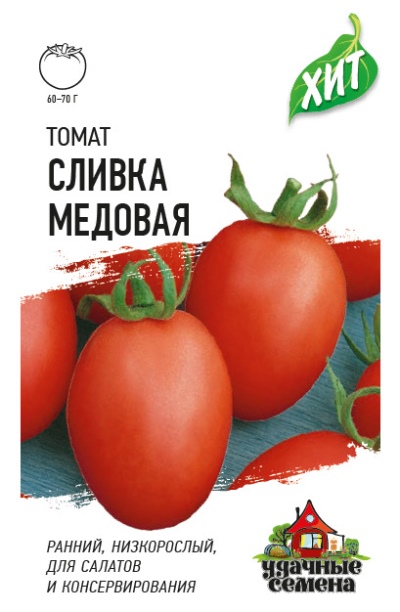
- Authors: Gavrish S.F., Morev V.V., Amcheslavskaya E.V., Degovtseva T.V., Volok O.A., Vasilyeva M.Yu.
- Year of approval: 2019
- Category: grade
- Growth type: determinant
- Appointment: fresh consumption
- Ripening period: early
- Ripening time, days: 93-100
- Growing conditions: for film greenhouses
- Bush size: undersized
- Bush height, cm: up to 60
Tomato Honey cream is one of the most delicious and surprisingly beautiful varieties. Designed for growing both in open and protected ground.
Breeding history
Not so long ago, or rather, in 2017, the well-known breeding company Gavrish submitted an application for inclusion in the State Register of the Honey Cream variety it had bred. The authorship of the development belongs to a fairly large group of breeders consisting of S.F. Gavrish, V.V. Morev, E.V.Amcheslavskaya, T.V. Degovtsova, O.A. Volok and M.Yu. Vasilyeva. the culture was entered in the State Register for the Russian Federation and zoned for cultivation practically throughout the country.
Description of the variety
Determinant bushes of a low-growing tomato variety Honey Cream stop their growth at around 60 cm. The bushes are semi-spreading, moderately leafy. The leaves are not very large, their color is green. The inflorescence is simple, the stalk is articulated.
The main qualities of the fruit
The name of the tomato Honey cream perfectly characterizes the main features of the variety. They are plum-shaped, smooth, without a spout. In terms of color, green unripe tomatoes turn bright red when ripe. The tomatoes are small, maximum 60–70 g. The number of seed nests is 2 or 3. The ripened clusters look very impressive, behind them you can't even see the foliage.
Taste characteristics
The pulp of Honey Cream has a wonderful sweet harmonious taste and inimitable aroma. At the same time, these vegetables are very useful, since they contain a lot of vitamin C, the antioxidant lycopene, as well as a large amount of fructose, which makes them a useful children's delicacy, they are also liked by lovers of sweet tomatoes. The fruits are beautiful and neat, almost all of the same size, so they look great in summer salads and are literally made for canning and freezing whole fruits.
Ripening and fruiting
The Honey Cream variety is a typical representative of the early ripening group of fruits. Fruiting begins 93–100 days after seed germination.
Yield
The marketable yield of the variety is noted at the level of 8 to 9 kg from 1 m 2 of plantings.
The timing of planting seedlings and planting in the ground
Sowing of honey cream seeds for seedlings is done, as a rule, in March or at the beginning of April. It is necessary to pick plants after the appearance of the first leaf. Then the seedlings are transplanted into the ground, according to the schedule it can be in early or mid-May, or in late May - early June. This will depend on climatic conditions.

Growing tomato seedlings is an extremely important process, because it largely depends on whether the gardener can harvest at all. All aspects must be taken into account, from seedbed preparation to planting in the ground.
Landing scheme
The bushes are small, so you can plant them in rows. Experts recommend leaving about 40 cm between the bushes, 60 cm between the rows. The maximum density can be about 7 bushes per 1 m 2.

Growing and care
The Honey Cream variety needs moderate pinching. Top dressing of the culture is needed, it is carried out 2 to 3 times during the growing season. When planting, they are fed with organic and nitrogen mixtures. Further, after the ovaries begin to appear, it is necessary to make potassium and phosphorus fertilizers. This will support the young stems. The final stage of dressing is during the ripening of the fruits.
It is better to plant tomatoes in a soil where parsley and zucchini, dill and cauliflower, carrots and cucumbers were cultivated before. Twice a week, plants are watered with rather warm water, they do this either before sunrise or after sunset. But they do this only after the soil under the bushes has completely dried. In this case, the water must be defended in the sun.




A plant needs different micronutrients at each stage of growth. All fertilizers can be divided into two groups: mineral and organic. Folk remedies are often used: iodine, yeast, bird droppings, eggshells.
It is important to observe the rate and period of feeding. This also applies to folk remedies and organic fertilizers.
Disease and pest resistance
The Honey Cream variety is quite resistant to both verticillosis and fusarium wilt.



























































































